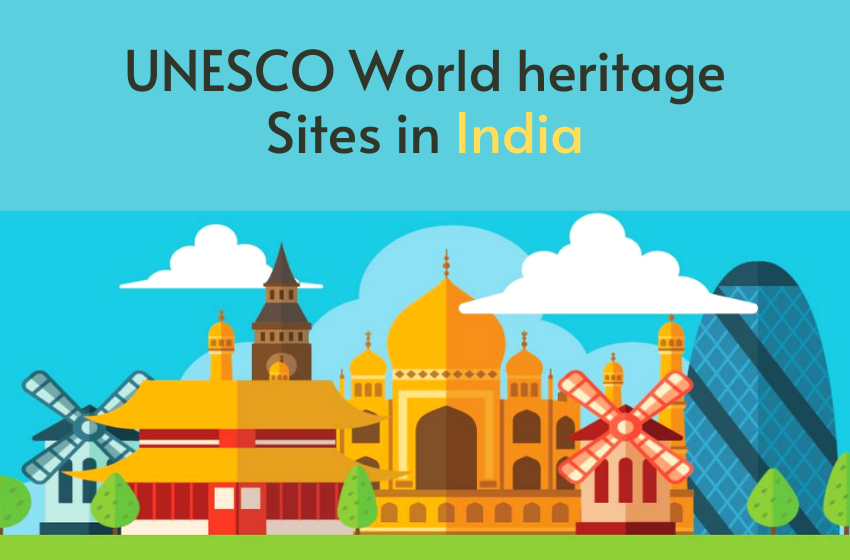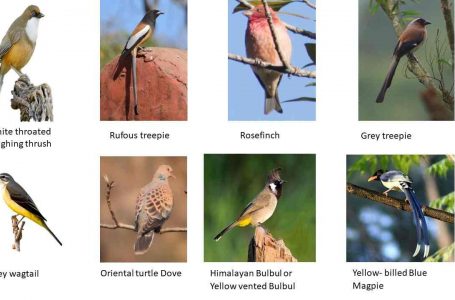UNESCO – World heritage Sites in India

UNESCO (United Nations Educational, Scientific, and Cultural Organization) endeavors to create peace into international assistance in Education, the Sciences, and Culture. UNESCO’s programs provide the fulfillment of the Sustainable Development Goals marked in Agenda 2030, ratified by the UN General Assembly in 2015.
Administrative and economic organizations of states are not quite to secure the constant and sincere support of the masses. Peace must be established against dialogue and common understanding. Peace must be made against the intellectual and ethical solidarity of humankind.
UNESCO produces institutional tools to assist people to live as global residents free of hatred and bigotry. UNESCO works so that every child and citizen should have access to quality education.
By supporting the cultural system and the corresponding dignity of all cultures, UNESCO encourages bonds between nations.
UNESCO promotes scientific programs and procedures as platforms for improvement and cooperation. UNESCO attains up for freedom of expression, as a fundamental right and an essential condition for equality and development. Serving as a workroom of thoughts, UNESCO supports countries use international standards and maintains programs that promote the open stream of ideas and education distribution.
Table of Contents
Key Facts
- UNESCO conserves 1073 world heritage places in 167 countries.
- UNESCO coordinates tsunami advanced alarm systems all over the earth.
- UNESCO protects global attempts to reach quality education for all.
- UNESCO began the repair of the mausoleums in Timbuktu.
- UNESCO started the sesame world-class analysis laboratory in the middle east.
- UNESCO reaches up for the freedom of interpretation and condemns the slaying of journalists.
- 193 member countries, 11 associate members, 11000 associated schools.
- 177 nation parties to the impalpable heritage convention.
UNESCO History
As old as 1942, in wartime, the rules of the European nations, which implied facing Nazi Germany and its collaborators, assembled in the United Kingdom for the CAME (Conference of Allied Ministers of Education).
Against the proposal of CAME, a United Nations Conference for the corporation of an educational and cultural foundation was secured in London. In their centers, the new system must ascertain this to prevent the eruption of another world war.
The countries that have signed the World Heritage Convention and are willing to protect their natural and cultural heritages are eligible to submit their proposals for nomination of their properties under the UNESCO World Heritage List.
Nomination Process
Tentative list
The nation willing to submit its proposal must create a Table containing the information of its natural and artistic heritage sites. This ‘table’ is identified as the TL and proffers a forecast of the attributes that a State Party may choose to submit for inscription in the next five to ten years and which may be refreshed at any time.
The Nomination File
By making a Tentative List and picking sites from it, a State Party can plan when to perform a nomination file. The World Heritage store allows direction and helps the State Party in serving this file, which wants to work as exhaustively as feasible, producing sure the basic documentation and maps are incorporated. The nomination is offered to the World Heritage Centre for study and to tell it is complete. Already a nomination file is finished the World Heritage Centre sends it to the proper Deliberative Bodies for evaluation.
The Advisory Bodies
A proposed property is separately evaluated by two Deliberative Bodies mandated by the World Heritage Convention ICOMOS and the International Union for Conservation of Nature (IUCN), which sequentially give the Committee with evaluations of the artistic and essential sites nominated. The third Deliberative Body is the ICCROM, an intergovernmental group that provides the Committee with expert guidance on the preservation of cultural positions, as well as on practice exercises.
The World Heritage Committee
Once a site becomes nominated and assessed, it is timely for the inter-governmental Committee to obtain the final judgment on its writing. Once a year, the Committee meets to select which sites will be recorded on the List. It can also delay its determination and request further knowledge on sites of the Events Parties.
The Criteria For Selection
To be carried on the List, sites must be of excellent common value and appear at the smallest one out of ten selection criteria. These criteria are described in the Operational Guidelines for the Implementation of the Convention which, besides the text of the Convention, is the main performance tool on World Heritage. The rules are constantly examined by the Committee to reflect the growth of the World Heritage concept itself.
Until the end of 2004, sites remained chosen on the basis of six cultural and four simple criteria.
Cultural Sites in India
1. Ajanta Caves
Ajanta caves were in two phases, the first phase was to build Ashoka Emperor and the second phase in Gupta’s period. These caves were built in the 2nd century BCE and after that, the second phase was built around 400–650 CE. These caves are located in Maharashtra. The caves contain Fresco paintings, Sigiriya paintings, and Sculptures in Sri Lanka. The 31 rock-cut cave monuments represent Buddhism religion.
2. Ellora Caves
It was also built in two phases, the first phase was built by Krishna 1 who was the uncle of Dantidurga and the second phase was built in the Rashtrakuta period. It was built from 600-1000 AD. It is situated in Maharashtra. Ellora caves depict Buddhism, Hinduism, and Jainism that is why it is known as the Ellora complex. There are 34 monasteries and temples
3. Agra Fort
It was built by Mughal emperor Akbar and further by his grandson Shah Jahan in the 16th century. It is situated in Agra. It is a Fortress of red sandstone. It contains the Jahangir Palace and the Khas Mahal, constructed by Shah Jahan.
4. Taj Mahal
One of the seven wonders of the world, the Taj Mahal is the most beautiful monument in India. It is situated in Agra, Built by Emperor Shahjahan in the memory of his wife. It was built from 1631 to 1648. It was declared as UNESCO world heritage in 1983. The monument is made up of white marble and is a mausoleum. It is situated on the banks of the river Yamuna and covers almost 17 hectares of land.
5. Sun Temple
It was built by King Narasimhadeva I in the 13th century and is situated in Konark. It is also known as “Black Pagoda”. This temple is visited by the Hindu devotees who believe in God Surya. It was declared as UNESCO in 1984.
6. Kaziranga National Park
It was established by the Government of India as a forest reserve in 1908. It is situated in the district of Assam. It was declared as a national park in 1974 and was put under the UNESCO list in 1985.
7. Sundarbans National Park
In 1984, the Sundarban tiger reserve was declared as a national park by the Government of India. It is situated in the Sundarbans basin in west Bengal. It got its space under the UNESCO world heritage sites in 1987. This region where this park is located has a thick forest cover of mangrove forest.
8. Nanda Devi and Valley of Flowers National Park
It was declared as a reserve park by Eric Shipton and H. W. Tilman in 1939. It is situated in Uttarakhand and has a rich variety of both flora and fauna. It has a total landmass of 87.5 Km. It got its space under the UNESCO world’s heritage list in 1988.
9. Archaeological Site of Nalanda Mahavihara at Nalanda, BIHAR
Remains of a religious and academic custom beginning from the 3rd century BCE to the 13th hundred CE. Admits stupas, memorials, viharas (residential and educational buildings), and relevant artworks in stucco, stone, and metal are found here. Studied to be the various old universities of the Indian Subcontinent. It got space in the UNESCO world heritage site’s list in 2016.
10. Buddhist Monuments at Sanchi
It was built under the Mauryan empire in the 2nd and 1st centuries BC to the 12th century AD. It is the most beloved Buddhist shrine and a major Buddhist center in India. Consists of consistent pillars, palaces, temples, and cloisters all in different categories of conservation most of which date back to the 2nd and 1st hundreds B.C. it was discovered by archaeologists in 1818. It is situated in Madhya Pradesh and got listed under the UNESCO world heritage sites in 1989.
11. Champaner-Pavagadh Archaeological Park
This Park consists of the old (chalcolithic) places, a hill citadel of the early Hindu capital, and remains of the 16th-century Gujarat. Also covers, amongst other remains, villas, palaces, religious buildings, suburban precincts, rustic structures, and water investments, from the 8th to 14th centuries. The Kalika Mata Temple on top of Pavagadh Hill is estimated to be an extraordinary shrine, bringing large quantities of travelers during the year.
12. Chhatrapati Shivaji Terminus (formerly Victoria Terminus)
Illustration of Victorian Medieval Revival structure in India blended with themes deriving from Indian traditional construction. It was opened in the year 1887. It is situated in Mumbai and got listed under the UNESCO world heritage sites in 2004.
13. Churches and Convents of Goa
It was built by the Portuguese colonial rulers between the 16th to 18th centuries in Goa. The churches and retreats of Goa, individually the Basilica of Bom Jesus indicate the origin of evangelization in Asia. Jesus also houses the divine tomb of St. Francis Xavier. It was put under the UNESCO list in 1986.
14. Elephanta Caves
Placed at Elephanta island or bar of Gharapuri in the Sea of Oman, near to Mumbai was excavated between near about 8 th century by rashtrakuta kings. Includes a collection of rock art compared to the Shaivite band. It was listed under the UNESCO world heritage sites in 1987.
15. Fatehpur Sikri
Created during the next half of the 16th century by Emperor Akbar, Fatehpur Sikri, or ‘The City of Victory,’ also worked as the capital of the Mughal empire for a quick time period. It comprises an arrangement of columns and temples, including one of the greatest mosques in India- the Jama Masjid.
16. Great Living Chola Temples
Created by kings of the Chola empire, certain temples exhibit the exactness and completeness of the Cholas in architecture, carving, painting, and bronze casting. This section includes three 11th and 12th- century temples: Brihadisvara Temple at Thanjavur, Brihadisvara Temple near Gangaikondacholisvaram, and Airavatesvara Temple near Darasuram. It was listed under UNESCO world heritage sites in 1987.
17. Group of Monuments at Hampi
This section was the last initial of the kingdom of Vijaynagar. Those Dravidian temples and mansions were built by administrators of Vijaynagar within the 14th and 16th hundreds. In 1565, the city that remained captured by the Deccan Muslim Confederacy and destroyed for a period of 6 months, is being discarded. It was listed under the UNESCO world heritage sites in 1986.
18. Group of Monuments at Mahabalipuram
This order of monuments was established by Pallava kings in the 7th and 8th hundreds on the Coromandel shoreline of the Bay of Bengal. Certain temples triumph over difficult and individual architectural styles in the form of- rathas (temples in the design of chariots), mandapas (cave sanctums), and giant open-air releases such as – ‘Descent of the Ganges.’
19. Group of Monuments at Pattadakal
It was built under the Chalukyas Dynasty between the 6th to 8th centuries at Aihole, Badami, and Pattadak. Pattadakal in Karnataka showcases an unprecedented mixture of design forms from northern and austral India, completed under the Chalukya dynasty through the 7th and 8th hundreds. It comprises nine Hindu topes as well as a Jain sanctum including some Temple of Virupaksha, a gem built in C.740 by Queen Lokamahadevi to memorialize her husband’s supremacy. It was listed under the UNESCO world heritage sites in 1987.
20. Hill Forts of Rajasthan
This site contains six majestic forts situated in Chittorgarh, Kumbhalgarh, Sawai Madhopur, Jaisalmer, Jaipur, and Jhalawar, by the Rajputs all located in the Aravali mountain range of Rajasthan. It got space in the UNESCO world heritage site’s list in 2013.
21. Rani ki VAV
Also known as the queen’s stepwell was built in the 11th century by the widow of a kind in his memory. It shows the great work of architecture. It is 64 m (210 ft) long, 20 m (66 ft) wide and 27 m (89 ft) deep and there are more than 500 sculptures of god. It got space in the UNESCO world heritage site’s list in 2014.
22. Historic City of Ahmedabad
Founded by Sultan Ahmed Shah 1 in the 15 th century on the eastern shore of the Sabarmati river. It was additionally labored as the metropolis of the state of Gujarat for ages. The urban fabric consists of densely-packed established organizations (pols) in gated traditional streets (puras). It got space in the UNESCO world heritage site’s list in 2017.
23. Humayun’s Tomb, Delhi
Built-in 1570 by Bega Begum (Humayun’s eldest widow) and situated in Delhi..it has long- standing aesthetic importance because it survived the initial garden-tomb to be assembled in India. Here, the tomb was influenced following several developmental variations including the Taj Mahal. The architecture of this tomb was made by Mirza Ghiyath. It got listed under the UNESCO world heritage list in 1993.
24. Khajuraho Group of Monuments
It was built under the Chandela dynasty between 950 AD to 1050 AD. It is situated in Madhya Pradesh. Only 20 temples remain, referring to two separate denominations namely-Hinduism and Jainism, including the famed Temple of Kandariya, finished with intricately and elegantly chiseled statues. It was included under UNESCO world heritage sites in 1982.
25. Mahabodhi Temple Complex at Bodh Gaya
This temple stood first built by Emperor Asoka in the 3rd century B.C. Nevertheless, the existing house dates following the 5th or 6th hundreds. It is situated in Bodh Gaya. This temple means a lot to the Buddhist people. Buddhist believe that Siddhartha Gautama Buddha got great knowledge in this temple. It got space under the UNESCO world heritage sites in 2002.
26. Mountain Railways of India
Darjeeling Himalayan Railway- The credit goes to Ashley Aden for bringing up the toy train rail network. It was built between 1879 and 1881. The total distance the toy train covers is 88 km. It got space under the UNESCO world heritage sites in 1999.
Nilgiri Mountain Railway- A meter gauge railway in Tamil Nadu was built by the British in 1908. It is operated by the southern railway between Coonoor and Udhagamandalam. It got space under the UNESCO world heritage sites in 2005.
Kalka Shimla Railway- A narrow-gauge train in north India and runs between Kalka to Shimla was built by the Britishers between 1898 and 1903 under the direction of Herbert Septimus Harington. It got space under the UNESCO world heritage sites in 2008.
27. Qutub Minar and its Monuments, Delhi
Qutub Minar abode was built in red sandstone in the old 13th centenary, in Delhi by Qutab-ud-din Aibak situated in Delhi. The pillar is enclosed by several aesthetically-pleasing wealth, for case the Alai built-in 1311 as well as two mosques including the Quwwatu’l-Islam, the most luxurious mosque in northerly India. It got space in the UNESCO world heritage sites list in 1993.
28. Red Fort Complex
Mughal Emperor Shah Jahan built this red fort complex in the 17th century as a part of his city Shahjahanabad. The Red Fort or Lal Quila is situated in Delhi. The architecture shows up the Persian, Taimuri, and Indian style architecture. It is made up of red stone. It got space in the UNESCO world heritage site’s list in 2007.
29. Rock Shelters of Bhimbetka
These screens are located inside the foothills of the Vindhya Range, in Madhya Pradesh. Discovered in the form of five clusters of natural rock shelters exhibiting paintings in 1957, with 21 villages surrounding it. It got space in the UNESCO world heritage site’s list in 2003.
30. The Architectural Work of Le Corbusier
This transnational serial property includes 17 sites spread across 7 countries stands as a testimony of a new form of architectural expression weaved with modern traditions which were architecture by Le Corbusier of the 20 th century in Chandigarh. It got space in the UNESCO world heritage site’s list in 2016.
31. The Jantar Mantar, Jaipur
It was built in the early 18th century by Maharaja Jai Singh 2 in Jaipur. The main idea behind its design is to observe astronomical positions with the normal eye. It got space in the UNESCO world heritage site’s list in 2010.
32. Victorian Gothic and Art Deco Ensembles of Mumbai
This site includes a collection of public buildings designed in Victorian Neo-Gothic style in the 19th century and Art Deco style in the 20th century. These buildings include Bombay High Court, Rajabai Clock Tower, Eros Cinema and Convocation Hall, University of Mumbai, University Library, Mumbai. It got space in the UNESCO world heritage site’s list in 2018.
33. Great Himalayan National Park-Conservation Area
This park is located in the western part of the Himalayan Mountains in Himachal Pradesh. It is well known for its high alpine peaks, alpine meadows, and riverine forests. It also encloses glacial and snow meltwater sources of several rivers as well as the catchment area. It consists of 25 types of forest and a huge variety of fauna. . It got space in the UNESCO world heritage site’s list in 2014.
34. Keoladeo National Park
It was established in the 20th century by the government of India. This wetland is located in the state of Rajasthan and served as a duck shooting reserve till the end of the 19th century.
However, soon enough the hunting ceased and the area was declared a national park in 1982. It covers almost 1,000 hectares of land. It was put under the UNESCO list in 1985.
35. Manas Wildlife Sanctuary
It was established by the Government of India in the 20th century. It is a biodiversity hotspot in Assam. It was declared as the tiger reserve in 1973. It was put under the UNESCO list in 1985.
36. Western Ghats
The Western Ghats consists of a chain of mountains running parallel to India’s Western Coast and passing from the states of Kerala, Maharashtra, Goa, Gujarat, Tamil Nadu, and Karnataka. Stretches along the area of 1600 km, interrupted by a 30 km Palghat gap. It got space in the UNESCO world heritage site’s list in 2012.
37. Khangchendzonga National Park
Located in Sikkim, this National Park is dominated by the world’s third-highest peak, Mount Khangchendzonga. The Park comprises steep-sided valleys, snow-clad mountains, and various lakes and glaciers including the 26km long Zemu glacier, located around the base of Mount Khangchendzonga. It got space in the UNESCO world heritage site’s list in 2016.
38. Jaipur
Founded in 1727 by Sawai Jai Singh 2, Jaipur is a part of the Rajasthan state of India. This state shows the combination of the ideas of both the ancient Hindus and the modern Mughals. It got space in the UNESCO world heritage site’s list in 2019.
Tentative UNESCO World Heritage Sites in India
38 sites from India have already been listed in the UNESCO world heritage sites and there are 43 sites in India which are submitted to UNESCO and are waiting for evaluation and acceptance. Here is the tentative list:
- Temples at Bishnupur, West Bengal (1998)
- Neora Valley National Park (2009)
- Santiniketan (2010)
- Mattancherry Palace, Ernakulam, Kerala (1998)
- Padmanabhapuram Palace (2014)
- Ancient Buddhist Site, Sarnath, Varanasi, Uttar Pradesh (1998)
- Sri Harimandir Sahib, Amritsar, Punjab (2004)
- River Island of Majuli in midstream of Brahmaputra River in Assam (2004)
- Moidams – the Mound-Burial system of the Ahom Dynasty (2014)
- Namdapha National Park (2006)
- Thembang Fortified Village (2014)
- Wild Ass Sanctuary, Little Rann of Kutch (2006)
- Wild Ass Sanctuary, Little Rann of Kutch (2006)
- Dholavira: A Harappan City (2014)
- Archaeological remains of a Harappan Port-Town, Lothal (2014)
- Desert National Park (2009)
- The Qutb Shahi Monuments of Hyderabad Golconda Fort, Qutb Shahi Tombs, Charminar (2010)
- Monuments and Forts of the Deccan Sultanate (2014)
- Qutb Shahi Monuments at Hyderabad
- The Glorious Kakatiya Temples and Gateways (2014)
- Remnants of Swayambhu temple and Keerthi Thoranas, Warangal fort
- Rudreswara Temple, Hanumakonda
- Rudreswara (Ramappa) Temple, Palampet
- Mughal Gardens in Kashmir (2010)
- Cold Desert Cultural Landscape of India (2015)
- The Leh-Kargil areas of Ladakh
- Delhi – A Heritage City (2012)
- Bahá’í House of Worship, New Delhi (2014)
- Monuments and Forts of the Deccan Sultanate (2014)
- Bahmani Monuments at Gulbarga
- Bahmani and Barid Shahi Monuments at Bidar
- Adil Shahi Monuments at Bijapur
- Monuments of Srirangapatna Island Town (2014)
- Sacred Ensembles of the Hoysala (2014)
- Cellular Jail, Andaman Islands (2014)
- Narcondam Island (2014)
- Group of Monuments at Mandu, Madhya Pradesh (1998)
- The historic ensemble of Orchha (2019)
- Sri Ranganathaswamy Temple, Srirangam (2014)
- Chilika Lake (2014)
- Ekamra Kshetra – The Temple City, Bhubaneswar (2014)
- Cold Desert Cultural Landscape of India (2015)
- Spiti Valley
- Garo Hills Conservation Area (GHCA) (2018)
- Keibul Lamjao Conservation Area (2016)
Number of UNESCO World Heritage Sites- State-wise List
S.No. | States | Exclusive Sites | Shared Sites | Total |
1 | Assam | 2 | - | 2 |
2 | Bihar | 2 | - | 2 |
3 | Chandigarh | 1 | - | 1 |
4 | Delhi | 3 | - | 3 |
5 | Goa | 1 | - | 1 |
6 | Gujarat | 3 | 1 | 4 |
7 | Himachal Pradesh | 1 | 1 | 2 |
8 | Karnataka | 2 | 1 | 3 |
9 | Kerala | 0 | 1 | 1 |
10 | Madhya Pradesh | 3 | - | 3 |
11 | Maharashtra | 5 | 1 | 6 |
12 | Odisha | 1 | - | 1 |
13 | Rajasthan | 4 | - | 4 |
14 | Tamil Nadu | 2 | 2 | 4 |
15 | Uttarakhand | 1 | - | 1 |
16 | Uttar Pradesh | 3 | - | 3 |
17 | West Bengal | 1 | 1 | 2 |
18 | Sikkim | 1 | - | 1 |





